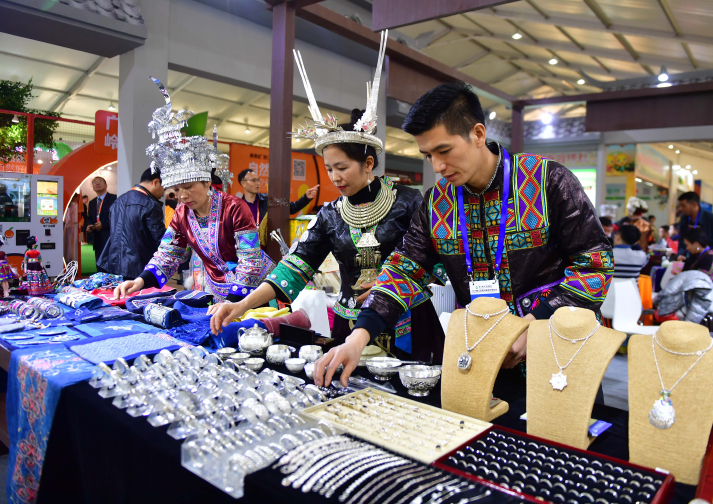| Lifestyle |
| The details are in the dress code | |
|
|
 Miao people in traditional dress (XINHUA)
'Without silver or flowers a girl won't be a girl," an old Miao minority saying goes. Silver is an important part of their culture, found to this day mostly in Guizhou Province, but also across Guangxi Zhuang Autonomous Region and Yunnan, Hunan, and Hainan provinces. All political affirmations and connotations aside, China's various traditional minority dress codes have had an extensive influence on clothing hangers (inter) nationwide, comprising the full scale from hard-to-handle fabrics to exuberant embroidery to fantastical earrings. Traditionally, their textiles, techniques, and accessories are used to preserve some of the histories of the minorities who never used a written language to document their stories. They are a source of artisanally treasured inspiration. Located in China's utmost western region, Xinjiang Uygur Autonomous Region with its green grasslands, icy blue mountain lakes, wide-stretching deserts and rapidly developing large cities, harbors 56 ethnic groups. The most distinctive Uygur feature in their dress code would have to be the daily-worn cap, referring to age, occupation, and ethnic origin, and the large hand-woven Atlas silk squares emblazoned with wildly colorful flowery motives produced in the area. "Atlas" is in fact a traditionally hand-woven pattern (on silk). The fabric embodies the Uygur people's wisdom and history; establishing a connection to their vibrant past and hopes for a bright future. From graphic prints, it's only a small leap to embroidery, brocades, and batik, yet more characteristics found across the tradition-prescribed clothing. Especially renowned for their sewing skills are the Miao (with a headcount of 9.4 million), located in China's southwestern province of Guizhou. Often depicting the natural landscape surrounding them, their most commonly depicted motifs include flowers, birds, and other fauna. From aprons to dresses to baby carriers to shoes and towering headwear, the Miao processing techniques are the primi inter pares, with colors often being on the more earthy-honed side. On the brighter side of the color palette, we might find the Yunnan (the bright home to 25 minority groups) motives. As we swiftly sweep through China's southern areas, we stumble upon another firm favorite: the silver gems. Cap adornments, extralarge drop earrings or brooches, and bracelets; the entire shiny shebang is present among the many minorities settled there since the 19th century. While in the majority of China's population (who are of Han descent) the favorite materials for ornaments are jade, gold, and silk, for ethnic minorities, silver is the protagonist. Silver signifies beauty, affluence, and is a talisman against evil spirits; the bigger, fancier and more ornate, the better. With the location's earliest silver accessories dating back to the Song Dynasty (960-1279), these craftsmen know their molding and carving, often inlaying the basic pieces with precious stones, including agate, jasper, and turquoise. Miao women, for example, wear extremely ornate silver headdresses, collars, breastplates, chains, aprons, and back pendants that often hang down to the waist, as well as bracelets, earrings, hairpins, and bells on special occasions, such as weddings and folkloric dances. The crown-like headdresses are so tall and elaborate they resemble chandeliers. Curved silver horns sometimes top the headdresses, whose raised patterns can depict dragons playing with a pearl. One woman's silver ensemble can weigh more than 20 kg. Designs are intricately embossed into flower, butterfly, animal, and spiral shapes, with delicate filigree. From the time a Miao woman is a child, she has silver jewelry she inherits from her family. By the time she weds, her collection grows as her family buys more ornaments. With an array of 56 ethnic groups covering the vast landmass of China, one can infuse any outfit with a mad minority bump in a straight stitch second. The author is an editorial consultant with Beijing Review Comments to dingying@bjreview.com |
|
||||
|
||||||||||||||||||||||||||||
|